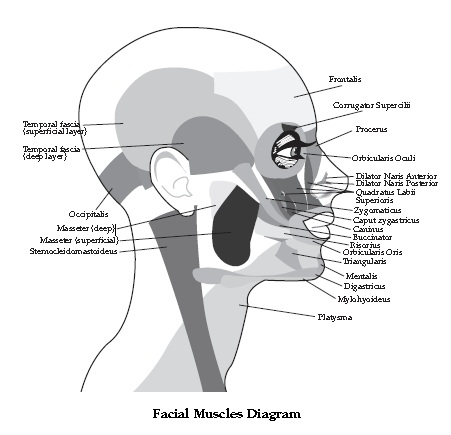Anatomy Lessons on Instagram Smile for the Muscles of Biology Diagrams Nasal Group. The nasal group of facial muscles are associated with movements of the nose and the skin surrounding it.. Nasalis. The nasalis is the largest of the nasal muscles and is comprised of two parts: transverse and alar.. Attachments: Transverse part - originates from the maxilla, immediately lateral to the nose. It attaches onto an aponeurosis across the dorsum of the nose.

Learn about the facial muscles, a group of about 20 flat skeletal muscles that produce facial expressions. See diagrams, names, origins, insertions, innervation and blood supply of each muscle group. 2) Occipitalis - not shown on diagram (in back): a. Actions: pulls scalp back b. Innervation: Facial Nerve (Vll) c. Origin: from posterior back of skull d. Insertion: to anteriorly with the galea aponeurotica 3) Orbicularis oculi (sphincter muscle of the eyelid): a. Actions: squinting, closes eye, crowsfeet, eye bags b. Innervation: Facial Kenhub offers a comprehensive guide to learn the facial muscles anatomy, function and innervation. You can practice with labeled diagrams, interactive quizzes and videos.

Anatomy, Head and Neck: Facial Muscles Biology Diagrams
The following interactive diagram of muscles of human facial expression is an anterior view of some of the muscles and tissues of the head (useful for Indian head massage courses). Click on the pink questions for immediate answers. The muscles / tissues listed below are included in the diagram above. (The numbers are how the muscles are

There are about 20 flat skeletal muscles that construct the facial structure. All of these muscles have different functions in the face. Innervated by the cranial nerve, which is the facial nerve, the muscles control all of our facial expressions. These muscles of the face can be grouped in different categories, depending on their position. Let us have a look at the 20 different muscles of our The facial muscles are also known as the muscles of the facial expression or the mimetic muscles. These muscles are a group of approximately 20 superficial skeletal muscles of the face and scalp divided into five different groups according to their location and function. These groups include: Buccolabial (oral) group: Levator labii superioris, levator labii superioris alaeque nasi, risorius

Muscles of the Face, Head, and Neck Biology Diagrams
Learn about the 20 facial muscles that control your face movements, such as chewing, smiling and talking. Find out what conditions and disorders can affect the facial muscles and how to seek medical attention.
